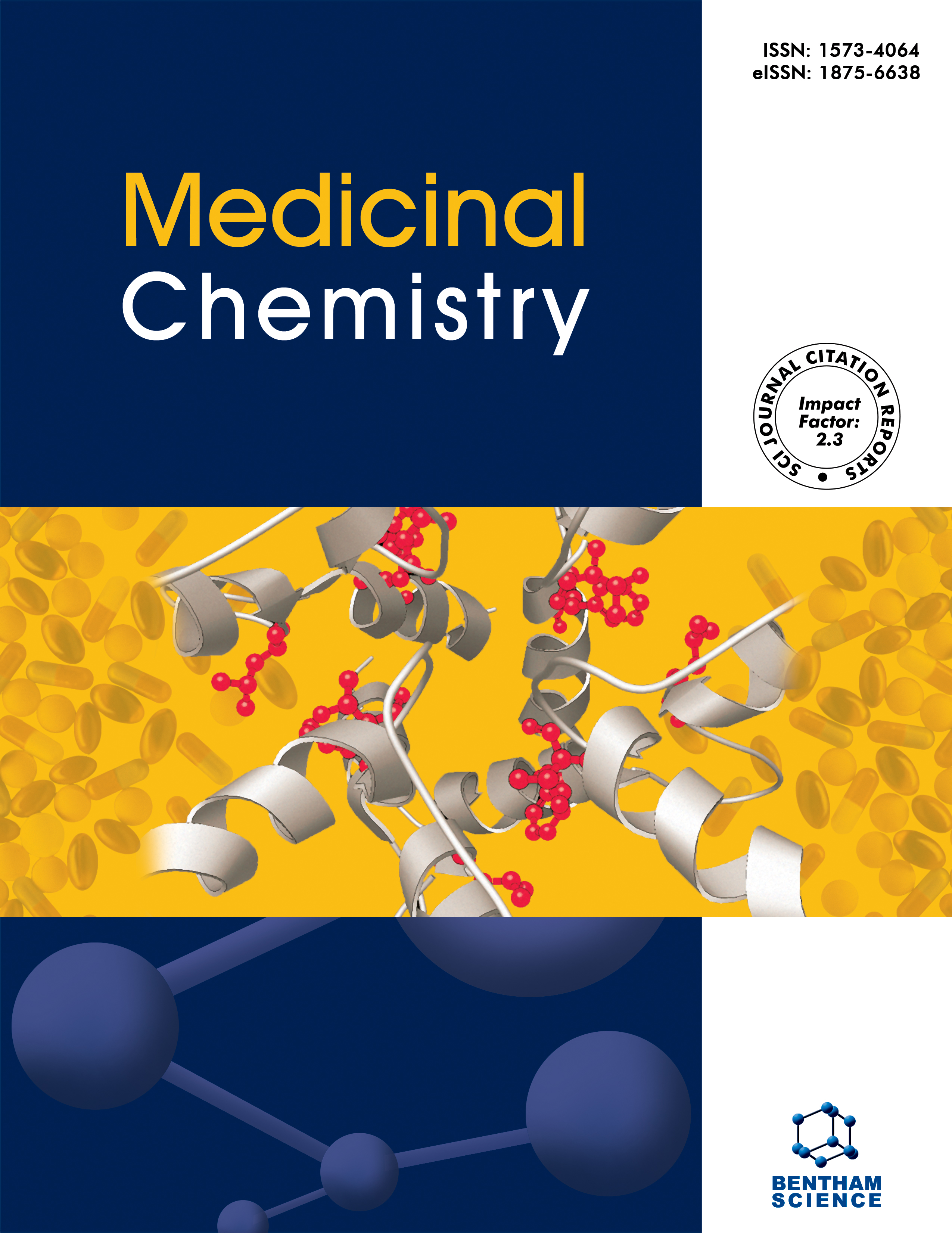- Home
- A-Z Publications
- Medicinal Chemistry
- Previous Issues
- Volume 1, Issue 4, 2005
Medicinal Chemistry - Volume 1, Issue 4, 2005
Volume 1, Issue 4, 2005
-
-
Modelling of Aldose Reductase Inhibitory Activity of Pyrrol-1-yl-acetic Acid Derivatives by Means of Multivariate Statistics
More LessAuthors: A. Tsantili-Kakoulidou, I. Nicolaou, D. Vrakas and V. J. DemopoulosThe inhibition of the aldose reductase enzyme (AR) is considered to be a promising approach to control chronic diabetes complications as well as a number of other pathological conditions. Thus considerable efforts are devoted to the development of aldose reductase inhibitors (ARIs) as possible pharmacotherapeutic agents. The establishment of adequate QSAR models would serve to this purpose. In the present study multivariat Read More
-
-
-
Bangladeshi Medicinal Plant Extracts Inhibiting Molecular Interactions between Nuclear Factors and Target DNA Sequences Mimicking NF-kB Binding Sites
More LessAuthors: I. Lampronti, M. T.H. Khan, N. Bianchi, A. Ather, M. Borgatti, L. Vizziello, E. Fabbri and R. GambariSeveral medicinal plants can be employed to produce extracts exhibiting biological effects. The aim of this work was to verify the ability of extracts derived from different medicinal plants of Bangladesh in interfering with specific DNA-protein interactions. The rationale for this study is based on the observation that alteration of gene transcription represents a very promising approach to control the expression of selected genes a Read More
-
-
-
Synthesis, Structure-Activity Relationships and Antagonistic Effects in Human MCF-7 Breast Cancer Cells of Flexible Estrogen Receptor Modulators
More LessAuthors: David G. Lloyd, Helena M. Smith, Timothy O'Sullivan, Daniela M. Zisterer and Mary J. MeeganEstrogen receptors are therapeutic intervention targets for diseases such as osteoporosis and breast cancer with both tamoxifen and raloxifene established as clinical estrogen receptor antagonists. We report a series of novel selective estrogen receptor modulators (SERMs) whose structures are based on a flexible core scaffold differing from the triphenylethylene of tamoxifen analogues through the insertion of a benzylic met Read More
-
-
-
Computational Insight into Anti-mutagenic Properties of CYP1A Flavonoid Ligands
More LessAuthors: Rute d. Fonseca, Michele Marini, Andre Melo, Maria Cristina Menziani and Maria Joao RamosCytochrome P450 1A (CYP1A) is a subclass of enzymes involved in the biotransformation of heterocyclic amines present in cooked red meat to carcinogenic compounds. Anti-cancer properties have long been associated with flavonoids, and some compounds of this class have been shown to interact directly with CYP1A2. The understanding of this interaction is the purpose of this work. As the number of experimentally tested Read More
-
-
-
New non-peptidic Inhibitors of Papain Derived from Etacrynic Acid
More LessAuthors: U. Kaeppler and T. SchirmeisterCysteine proteases are connected to various viral and parasitic infections, as well as to other severe diseases like arthritis, stroke and cancer. Due to its α,β-unsaturated carbonyl moiety etacrynic acid, a well known diuretic, can inhibit cysteine proteases in a Michael-type reaction by reaction with the nucleophilic cysteine residue of the active site. For first structure-activity-relationship studies modifications at various positions Read More
-
-
-
QSAR of the Anticonvulsant Enaminones; Molecular Modeling Aspects and other Assessments
More LessAuthors: T. L. Wilson, P. L. Jackson, C. D. Hanson, Z. Xue, N. D. Eddington and K. R. ScottThe enaminones represent potentially useful agents for the clinical treatment in generalized tonic-clonic seizures (Epilepsia, 1993, 34(6), 1141-1145, Biopharm. Drug Disp. 2003, 397-407). A regression analysis was performed to provide a quantitative structure-activity relationship (QSAR) correlation model for prediction of activity for the anticonvulsant enaminones. Molecular modeling was performed to determine the mol Read More
-
-
-
Topoisomerase Enzymes as Therapeutic Targets for Cancer Chemotherapy
More LessAuthors: Gregory I. Giles and Ram P. SharmaThe topoisomerase enzymes are essential for DNA metabolism, where they act to adjust the number of supercoils in DNA, a key requirement in the cellular processes of transcription and replication. Their enzymatic mechanism creates transient nicks (type I) or breaks (type II) in the double stranded DNA polymer, allowing DNA to be converted between topological isomers. Humans possess both types of topoisomerase enzy Read More
-
-
-
Role of Prostaglandin E Receptor Subtypes in Gastroduodenal HCO3 - Secretion
More LessAuthors: Koji Takeuchi, Eitaro Aihara, Masamune Hayashi and Yoko SasakiGastroduodenal HCO3 - secretion is a key process that aids in preventing acid-peptic injury. Endogenous prostaglandins (PGs) play a particularly important role in the local control of this secretion. The secretion of HCO3 - in both the stomach and duodenum was increased in response to PGE2 as well as mucosal acidification, the latter occurring with concomitant enhancement of mucosal PG generation. These HCO3 - responses Read More
-
-
-
GPCR Agonists and Antagonists in the Clinic
More LessAuthors: Joel D. A. Tyndall and Radhika SandilyaThis review describes current and new therapeutic agonists and antagonists of G-protein-coupled receptors (GPCRs) currently used in the clinic. GPCRs are classified under the GRAFS system (Glutamate, Rhodopsin, Adhesion, Frizzled/taste2 and Secretin), with therapies having been developed for about 30 GPCRs from the glutamate, rhodopsin and secretin families. Most of these therapies target the biogenic amine r Read More
-
Volumes & issues
-
Volume 21 (2025)
-
Volume 20 (2024)
-
Volume 19 (2023)
-
Volume 18 (2022)
-
Volume 17 (2021)
-
Volume 16 (2020)
-
Volume 15 (2019)
-
Volume 14 (2018)
-
Volume 13 (2017)
-
Volume 12 (2016)
-
Volume 11 (2015)
-
Volume 10 (2014)
-
Volume 9 (2013)
-
Volume 8 (2012)
-
Volume 7 (2011)
-
Volume 6 (2010)
-
Volume 5 (2009)
-
Volume 4 (2008)
-
Volume 3 (2007)
-
Volume 2 (2006)
-
Volume 1 (2005)
Most Read This Month
Article
content/journals/mc
Journal
10
5
false
en


